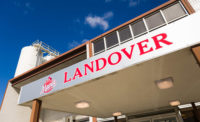Maryland & Virginia Milk Producers Cooperative Association is embracing the winds of change
With a recent shift in its go-to-market strategy and an emphasis on ‘fresh and local,’ the cooperative is positioned for growth.












Maryland & Virginia Milk Producers Cooperative Association Inc. (MDVA) lays claim to much more than a long name. The Reston, Va.-based dairy cooperative also boasts an impressively long history, celebrating its 100th anniversary in 2020.
MDVA operates a very vibrant, growing business, too. According to CEO Jay Bryant, the cooperative now delivers the equivalent of more than 5 billion glasses of milk each year to both consumers and food manufacturers here and abroad.
MDVA traces its roots to 1920, when an “impassioned group of dairy farmers” got together with the aim of supplying consumers in the nation’s capital with fresh milk, Bryant explains.
“They staked their claim on high quality standards and proximity to the market,” he notes. “The first decade was brutal, and the cooperative nearly folded. But those farmers didn’t quit — they put their heads together and found compromise with the milk dealers that resulted in much-needed market stability.”
John McGill, who led the organization as general manager from 1923 to 1934, really focused on forming the foundation of the cooperative, with the help of Frank Walker, who served as president. Since then, 10 other general managers/CEOs and 11 other presidents have worked to elevate MDVA to where it is today.
Bryant himself has been with MDVA for 21 years, becoming part of the organization when his employer of 12 years, Carolina Virginia Milk Producers, merged with MDVA back in 1999. He actually grew up on a small dairy farm in North Carolina, returning to work on the farm for a couple of years after graduating from North Carolina State.
The cooperative has grown considerably, of course, since its start more than a century ago. Its farmer-members now span from New York to Georgia. And MDVA operates four plants these days — two for consumer products and two for ingredients. But its mission has stayed the same.
“True to our roots, we’re still owned by farmers — over 900 of them, in fact,” Bryant says. “They’re as dedicated to supplying fresh, wholesome and nourishing dairy products today as they were in 1920. We’ve ratcheted up our standards, diversified our product offerings and expanded to serve customers around the world.”
Wide range of products, channels
MDVA’s products under its own brand or others’ brands include milk and flavored milk in multiple fat levels, half & half, heavy whipping cream, buttermilk, sour cream, cottage cheese, yogurt and eggnog, as well as dairy-based ingredients (bulk cream, condensed milk, butter and nonfat dry milk powder) that are marketed worldwide, notes Brian Linney, chief operating officer. He joined the cooperative in 2013 after spending 14 years with Seattle-based Darigold.
The products find a home in multiple channels, ranging from grocery stores, mass merchants and drug stores to foodservice outlets, schools, manufacturers and more. The cooperative’s brand, Maola Local Dairies, serves as the local dairy brand for the mid-Atlantic and Southeastern United States, Linney says. It covers a variety of milk products, as well as half & half, buttermilk and eggnog.
“Since 1920, the local dairy farm families who supply Maola fresh milk have been at the heart of everything we do,” he points out. “Each farm is unique, but there is one thing our farmer-owner families have in common: a shared passion for nourishing their communities with fresh, wholesome dairy goodness.”
To communicate that reality for its Maola brand, Linney notes that MDVA partners with key retail customers to develop print and digital promotions that are targeted to their specific consumers. The cooperative uses social media, too, to drive brand awareness and deliver key brand messages to consumers.
“It is also used to tell our farmers’ stories and make the connection back to our local brand,” he says.
A go-to-market shift
Today’s product mix reflects a major shift for MDVA. As recently as six or seven years ago, the cooperative’s primary business was selling raw milk to third-party processors, Bryant says. But margin pressures and changing market conditions prompted him to approach MDVA’s board with the idea of “getting closer to the consumer” while retaining a few key third-party processor customers.
“I said No. 1, it isn’t going to be easy, and more importantly, No. 2, it isn’t going to be cheap,” he explains. “And I made the comment that it’s going to take a lot of capital investment in our facilities. We can’t play the New York Yankees with the JV baseball team.”
The board has been extremely supportive of the shift, Bryant notes. In fact, MDVA has invested more than $50 million in three of its four plants since changing its go-to-market strategy. It now runs approximately two-thirds of its members’ milk through its own plants.
“We’ve spent a lot of capital, but we have increased the capacity of the plants,” he says. “We’ve also put in some different technology. … We’ve got a management team that has seen the opportunity to put capital into these plants and to grow the business, to have direct relationships with retailers like Costco, Food Lion, Giant Foods and Walmart and other leading retailers in our marketplace.”
The strategy seems to be working. In fact, unlike some other cooperatives, MDVA has not had to ask its farmers to dump any milk during the COVID-19 pandemic. Although the demand for school milk declined when the pandemic hit, the demand for dairy at retail ramped up, and the cooperative was able to pivot quickly to meet changing market needs.
“We were able to take all of our product in, and we had to deal with the crazy volatility in the powder market and the butter market and, quite frankly, the Class 1 and every other market,” Bryant says. “We could take our milk into our system and could make products out of it.”
In addition to plant investments, he credits MDVA’s leadership team with the pandemic-related response. In addition to himself and Linney, that team includes:
-
Jon Cowell, chief financial officer. He joined MDVA in 2018 after spending more than 20 years with Ocean Spray Cranberries Inc.
-
Mike John, chief operating officer, milk marketing. He joined MDVA in 2004 after spending six years with Land O’Lakes Inc. Prior to working for Land O’Lakes, John was with Atlantic Dairy Cooperative.
-
Todd Aarons, executive vice president of operations. He joined the cooperative in 2015 and boasts 30-plus years of dairy plant experience, including 10 years with Darigold.
-
Lindsay Reames, vice president of sustainability and external relations. Like Bryant, Reames grew up on a dairy farm. Prior to joining MDVA five years ago, she served as assistant secretary of agriculture and forestry for the Commonwealth of Virginia.
“We communicate to death, which I think is great,” Bryant says. “We also have leaders who understand that at our size and scale, we have to wear a lot of hats. So Brian Linney is over the sales and marketing … but at the same time, he might have to be out in a store at 4:00 in the morning checking the milk cooler to see how the deliveries are going.”
That wearing of multiple hats is something in which Bryant takes particular pride. It allows MDVA to be not only lean, but also responsive to its customers and members, he says.
Community-minded
As a cooperative touting a local brand produced by local farmers, MDVA long has been involved in its local communities. For example, it has lent its support to local state dairy shows and donated to local food banks, Bryant says. And back in May, MDVA members partnered with the Land O’Lakes Foundation to distribute 2,160 gallons of Maola milk in New Windsor, Md.
However, MDVA had no formal program in place for giving back to the community until only recently. And it was the pandemic that wielded an influence here. Members were calling to ask for truckloads of product to be sent here and there, and the cooperative stepped in “with both feet” whenever possible, Bryant notes.
“So it’s just been a matter of putting a lot of things that we’ve done into a more organized fashion and then growing and building on that,” he says, noting that Reames has been taking the lead in doing so.
The MDVA Fund is one thing to come out of those efforts. The cooperative established the fund in honor of its 100th anniversary to continue its charitable efforts, Reames says, and seeded it with $10,000.
“The MDVA Fund will embody the generosity of the cooperative’s membership and the organization’s long-standing tradition to support scholarships, sponsorships and product donations for a variety of dairy industry events, programs and organizations,” she says.
Although price “is still front and center” in customer conversations, Bryant says service has become an important topic as well.
“They now want to talk about what you’re doing in your community and what kind of a corporate citizen and leader you are,” he explains. “That’s another one of those stories that we love to tell, and we like it when they ask because we’ve got good things we can show.”
Sustainability standout
Another good “thing” MDVA has to show customers is a major award for its sustainability efforts. The Innovation Center for U.S. Dairy awarded the cooperative (in partnership with Turkey Hill Dairy and the Alliance for the Chesapeake Bay) the 2020 Sustainability Award for Supply Chain Collaboration for its work with the Turkey Hill Clean Water Partnership (THCWP), Reames points out.
“The award recognizes innovative projects and collaborative partnerships that have outstanding economic, environmental and social benefits, and that serve as a replicable model to inform and inspire others in advancing dairy sustainability leadership,” Reames notes.
To offset the costs of on-farm conservation practices such as creating and updating nutrient management plans, THCWP seeks out private funds, she explains. The money also helps fund projects such as forested buffer strip planting, manure storage capacity expansion and heifer barn construction for runoff reduction.
“Since its inception in 2018, THCWP has secured over $2 million in grants from the Natural Resources Conservation Service and the National Fish and Wildlife Foundation to support on-farm conservation efforts,” Reames says. “They have also helped farmers utilize over $2.5 million in support from PENNVEST, which provides low-interest loans and grants for nonpoint-source pollution-prevention best management practices.”
Thus far, THCWP has funded 42 conservation plans and committed $800,000 for implementation of on-farm conservation practices, she adds.
“Currently, 96% of the farms supplying milk to Turkey Hill Dairy have an updated conservation plan or are in the process of receiving an updated plan,” Reames says. “Through these efforts, the partnership has achieved pollutant load reductions totaling 421,327.5 pounds/year of nitrogen, 7,198.3 pounds/year of phosphorus [and] 2,920.9 tons/year of sediment.”
Looking to grow
As MDVA’s leadership team looks ahead to the next five years, it wants to further expand the amount of members’ milk running through its own plants, Bryant says. However, 100% is not the goal, as the cooperative does have “some very strategic core customers” on the raw milk side.
“It puts us more in control of our own destiny,” he explains. “It puts us more in a position to be able to tell our own story to our customers, who are the retailers that are actually interacting with the consumers in the marketplace. They want to see local. They want to see fresh. They want to see member-owned.”
MDVA’s position as local, fresh and member-owned certainly should help in its quest for growth. After all, these attributes mesh with those that younger generations desire in the foods and beverages they consume.
“We don’t live in Idaho. We don’t live in South Dakota. The majority of our footprint for our members is central Pennsylvania down through the Carolinas,” Bryant points out. “And there are a lot of people who live there, so local farmer-owned … two counties away means something to people, and they want to support that.”
Should the need arise, an additional plant also is a possibility, he suggests.
“We’ve never bought a plant and then looked around and tried to figure out, ‘OK, now what are we going to do with it?’ As we have more and more demand for our business or our supply and we grow relationships with retailers, if there’s an opportunity to continue to grow our business, we will do that,” Bryant says.
Looking for a reprint of this article?
From high-res PDFs to custom plaques, order your copy today!













